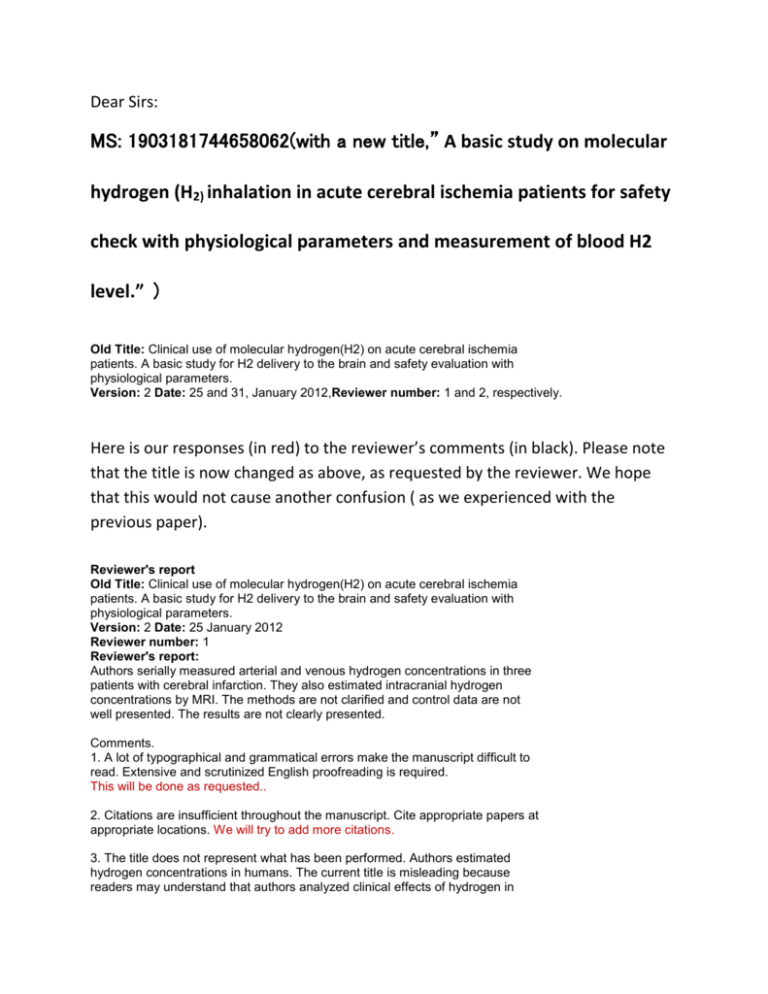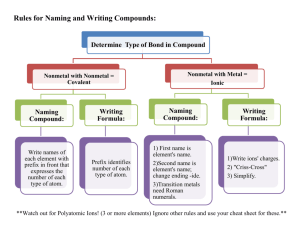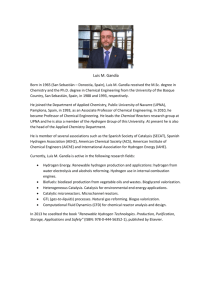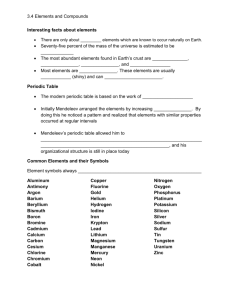MS: 1903181744658062(with a new title,” A basic study on
advertisement

Dear Sirs: MS: 1903181744658062(with a new title,” A basic study on molecular hydrogen (H2) inhalation in acute cerebral ischemia patients for safety check with physiological parameters and measurement of blood H2 level.” ) Old Title: Clinical use of molecular hydrogen(H2) on acute cerebral ischemia patients. A basic study for H2 delivery to the brain and safety evaluation with physiological parameters. Version: 2 Date: 25 and 31, January 2012,Reviewer number: 1 and 2, respectively. Here is our responses (in red) to the reviewer’s comments (in black). Please note that the title is now changed as above, as requested by the reviewer. We hope that this would not cause another confusion ( as we experienced with the previous paper). Reviewer's report Old Title: Clinical use of molecular hydrogen(H2) on acute cerebral ischemia patients. A basic study for H2 delivery to the brain and safety evaluation with physiological parameters. Version: 2 Date: 25 January 2012 Reviewer number: 1 Reviewer's report: Authors serially measured arterial and venous hydrogen concentrations in three patients with cerebral infarction. They also estimated intracranial hydrogen concentrations by MRI. The methods are not clarified and control data are not well presented. The results are not clearly presented. Comments. 1. A lot of typographical and grammatical errors make the manuscript difficult to read. Extensive and scrutinized English proofreading is required. This will be done as requested.. 2. Citations are insufficient throughout the manuscript. Cite appropriate papers at appropriate locations. We will try to add more citations. 3. The title does not represent what has been performed. Authors estimated hydrogen concentrations in humans. The current title is misleading because readers may understand that authors analyzed clinical effects of hydrogen in patients with cerebral infarction. The tile has been changed as you pointed out. Thank you. The new title is as below. We hope you like it better. “A basic study on molecular hydrogen(H2) inhalation in acute cerebral ischemia patients for safety check with physiological parameters and measurement of blood H2 level.” 4. Check typographical and grammatical errors including spaces like CH for HC, 30 min hydrogen treatment for 30-min hydrogen treatment, 20min for 20 min, a space before punctuation We will try our best. 5. Were all the patients alert enough to understand the study design and sign the consent form? Ethical issues should be addressed in detail. Some of the patients are not alert enough. In these situations, the family member usually took responsibility for the decision to participate in the study as in previous studies. However, more detailed sentences were added to that effect. 6. "q" for quaque is not commonly used in scientific papers. Reword it. Done. 7. Abbreviations should be spelled out at first including ecf, BE (B), and BB. Done as much as possible.. 8. As hydrogen concentrations are the only results to be reported in this paper, authors are required to explain how hydrogen concentrations in arterial and venous blood are measured in more detail. How big was the glass vessel? Was the glass vessel filled with hydrogen-free air in advance? How hydrogen concentrations were calibrated. How hydrogen was detected after separation with gas chromatography? The method we used was very common for the hydrogen measurement using the gaschromatography and has been described in the previous publications. However, more sentences are added. 9. State how authors administered hydrogen to three patients. How much were the concentrations? How hydrogen air was prepared? What kind of administration method was employed? 3% hydrogen gas was produced as in the previous publication and was given through a respirator for comatous and intubated patient and by a regular facial mask for the rest of the patients (12 ptietns). More sentences were added. 10. Indicate experimental evidence or cite an appropriate paper that 20.7% of hydrogen is lost from the plastic container. Please see References, #5 & 6. 11. Measurements of cerebral hydrogen concentrations by MRI are almost at the unquantifiable range in the standard curve. Fig. 1 demonstrates that cerebral hydrogen concentrations in the patients were under the detection threshold. In the Discussion, authors are well aware that the MRI measurements are unreliable. Eliminate MRI data. Done as you requested. 12. Explain why authors used a program that they developed by themselves. Feasibility, sensitivity, specificity, and errors of their own program should be indicated to exclude a possibility that their observations simply represent programming bugs. Since MRI data are removed, this question is irrelevant. 13. How did the ten patients inhale 3% hydrogen "at their own will and speed"? Was a fixed amount of 3% hydrogen air supplied to each patient through the mask? Yes. More explanation added. 14. Paragraph 4 of the Methods. Cite a reference for "our previous study". Done but needed more, please let us know. 15. The same paragraph. The review believes that authors did not "exclude" patients who declined venipuncture according to Fig. 5. Data of these excluded patients are not shown in the figure.. 16. State how hydrogen-enriched saline solution was prepared. How much were the hydrogen concentrations? Please see the reference #5 and #6. However, more sentences were added. 17. As authors measured arterial and venous hydrogen concentrations, calculate the half lives and/or the decay rate constants. These parameters are more informative than the values currently indicated in the manuscript. Evaluation of the dynamic data itself is not the purpose of this paper. Besides, the decay rate constants were in other manuscript prepared for publication for cerebral blood flow measurement with the hydrogen inhalation method and we would like to decline to disclose them at this moment. 18. The 2nd paragraph of Results are full of subjective statements that arise from authors subjective observations. Use scientific words and quantitative measures. Corrected. Response to Reviewer#2's report Version: 2 Date: 31 January 2012,Reviewer number: 2 Major Comments: • Abstract, Background: Please include a sentence summarizing the what type of benefits seen using H2 therapy in animals. Some sentences are added as suggested, up to the word count limit. • Abstract, Methods: Methods needs to include the dosage used, and shortly why that dosage used. Done as requested. • Abstract, Methods: Delivery method of H2 needs to be included (e.g. mask,inhalational, etc.).Sorry for our poor description. More sentences are added. • Introduction: Although the introduction is written well to support the study and manuscript, safety component was not mentioned at all. Dosage and related safety are key components to be mentioned in the Introduction. Especially, even in small doses how H2 is utilized, how it crosses the compartments, does it cross the blood-brain barrier, and whether it requires energy to cross membranes need to be mentioned in here. We have no expertise to answer some of above questions but we added more sentences to explain some of the questions. • Main difference between H2 and CO2 is –although they both will cause acidosis- CO2 crosses membranes freely and equilibrates quickly, but H2 will either need to wait for equilibration or energy requiring processes to cross the membranes. This difference complicates its utilization. It may have unexpectedly complicated pharmacokinetics and dynamics. H2 diffuses freely into the cells and through BBB by multiple animal studies. Some of references are added, hoping the questions are answered in them. . • Please indicate how much of a partial pressure (mmHg) 3-to-4% H2 will convert to. Additionally, how much of [H] increase or pH decrease to be expected when 3-to-4% H2 is used. This will contribute to the clinical relevance and safety of H2 therapeutics. Pure H2 are produced in the hydrogen water machine by filtering out of the H+ ion (by making the path of the H+ much narrower than that of OH- ), according to the published paper and therefore, dissolved H2 does not change the pH of the hydrogen water. This is the heart of their invention which are protected by the patent with at least several technical items. Therefore, the company did not include their hydrogen water but they used a conventional hydrogen water, as reported in a recent article by thee company (Medical Gas Reserch, vol 2 ,January issue, by Seo. • Why the investigators did not consider using a tight sealing or non-rebreathing mask system to optimize the delivery of H2? In such case, possibly the need for intravenous (iv) complementation would not be needed. Addition of iv delivery of H2 complicated the methods, and minimally contributed to the safety component because of very limited data reporting. Of course, we would like to use air-tight sealing masks but since these patients are participating to our study only after agreeing to the consent form which was approved by our ethics committee with clear statement that this inhalation is totally discomfort free procedure. Usually, multiple family members are watching the inhalation and if there is any sign of breath holding / hesitation/ or displeasure, they raised their hand to stop the inhalation. Therefore, the mask covers the mouth and nose completely but not air-tightly and provides 7 litter/min of 3% hydrogen/air/oxygen mixed gas with one way valve, so that that the patients feels outgoing and leaking gas which appears to soothe them. In this way, we could get more cooperation from the patients, particularly who are suffering from various degree of neurological deficits. Sorry for the lack of explanation. More sentences are added to that effect.. • If available the end-tidal partial pressure or concentration measurements of hydrogen would be very helpful to report, because such measurement would provide information on the delivery and consumption of hydrogen. We totally agree and we attempted only few occasions but failed to obtain good data. • What is the FDA status of H2? Please shortly mention in the manuscript. We have no idea at all at this moment regarding FDA status except as mentioned in a recent review article(Medical Gas Research, 2012 April Issue by Eckermann) but many articles appear to be using hydrogen gas as a non-drug therapy as an equivalent of NBO( normobaric oxygen therapy). In Japan, many companies and some medical clinics are selling hydrogen water and hydrogen gas as a health supplement. However, a majority of clinics and all the hospitals which receives health insurance payment from the government are not allowed to use any material with possible and even with a very minimal medical effect, including hydrogen, unless specifically approved by the government like our hospital.( The only Japanese health insurance policy available to the public is government subsidized and 100% government controlled, you like it or not.) Minor Comments: • Title, Page 1: Instead of “on”, please consider “in acute cerebral ischemia”. From request from other referee, the tile was changed and MRI related data were removed. We appreciate if you can evaluate our new title and see whether this is acceptable to you or not. • Introduction, Page 3, Para 3: First sentence, starting as “Since the expertise…”.This sentence has a complicated structure and meaning is compromised. Please consider separating this sentence to two different sentences. Thank you for the suggestion. We changed it into two sentences. • Results, Page 8, “HC in the blood”: Investigators mentioned that a plateau level reached. Were you aiming a specific hydrogen concentration in blood or brain? Please explain. We were not aiming at any certain level since there was no previous publications previously, regarding the correlation of hydrogen concentration in the inhaled gas in human and hydrogen concentration in the human blood as a response to the gas inhalation. However, we were hoping though, that the highest concentration with the inhalation reaches the blood level used in animal experiments. Therefore, we wanted to see the highest concentration for some duration (a plateau) with two different concentrations of hydrogen in the gas. • Results, Page 8, “HC in the blood”: Hydrogen concentration decreased slowly after discontinuation of delivery. This may raise some concerns for longer duration and higher dosage of using. Please discuss further in the discussion section. As mentioned above regarding discomfort associated with inhalation, we were looking at a shortest inhalation time possible and yet it reaches the animal experiment level. We are certainly comfortable the concentration of hydrogen inhaled to be at 3%, because this appears to achieve the animal experimental level but not much higher and with this plateau level, even the slow venous desaturation would reaches non significant level in about 10 min and there were no sign of accumulation which can occur if the concentration of an agent is too high . • Reference #3: The word “randomized” was spelled wrong. Please correct. Thank you for finding it. We will correct it. • Figure numbers are missing. Thank you again. We will fix it. • The figure containing the pH data is a clinically very important one. However, this reviewer suggests separating the pH from the top figure, and adding it (pH) as a separate figure showing the real decimal point pH changes. We tried it but the result was disappointing. This is because the pH is so stable that it still looks almost a straight line. These pH data were, 7.441, 7.447, 7.451, 7.448, 7.445, 7.419, 7.443, 7.432, 7.437, 7.436 and so on, with very small SD. So, sorry to tell you but we would like keep the figure as it is.






